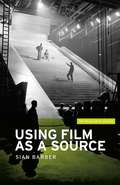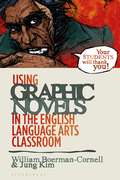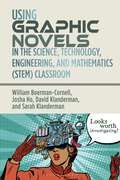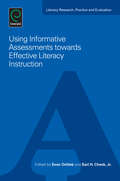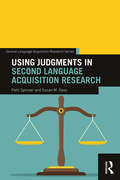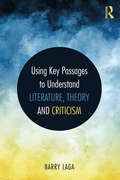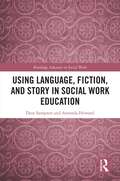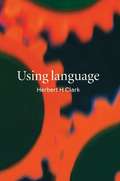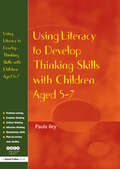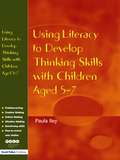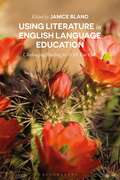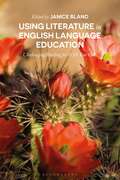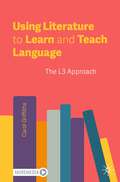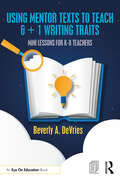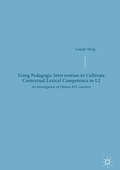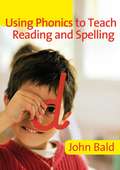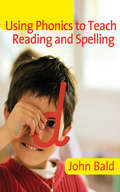- Table View
- List View
Using film as a source (IHR Research Guides #3)
by Sian BarberThis book is a hands-on study skills guide that explores how film and moving image can be used as sources. It is aimed at those who want to use film and moving image as the basis for research and offers advice on research methods, theory and methodology, archival work and film-based analysis. It draws on the disciplines of film and history to offer advice for students and researchers in these fields. The book includes sections on working with different kinds of moving images, how to explore visual sources, how to undertake film-related research and how to use film theory. In addition to providing detailed case studies, the guide also offers advice on research, writing and studying, creating a methodology, visiting archives, accessing material and exploring films from a historical perspective. The guide's focus is on good research practice, whether it be conducting an interview, visiting an archive, undertaking textual analysis or defining a research question.
Using film as a source (IHR Research Guides #3)
by Sian BarberThis book is a hands-on study skills guide that explores how film and moving image can be used as sources. It is aimed at those who want to use film and moving image as the basis for research and offers advice on research methods, theory and methodology, archival work and film-based analysis. It draws on the disciplines of film and history to offer advice for students and researchers in these fields. The book includes sections on working with different kinds of moving images, how to explore visual sources, how to undertake film-related research and how to use film theory. In addition to providing detailed case studies, the guide also offers advice on research, writing and studying, creating a methodology, visiting archives, accessing material and exploring films from a historical perspective. The guide's focus is on good research practice, whether it be conducting an interview, visiting an archive, undertaking textual analysis or defining a research question.
Using Graphic Novels in the English Language Arts Classroom
by William Boerman-Cornell Jung KimThere is an increasing trend in teachers using graphic novels to get their students excited about reading and writing, using both original stories and adaptations of classic works by authors such as Homer, Shakespeare, and the Brontes. However, there is surprisingly little research available about which pedagogies and classroom practices are proven to be effective. This book draws on cutting-edge research, surveys and classroom observations to provide a set of effective methods for teaching with graphic novels in the secondary English language arts classroom. These methods can be applied to a broad base of uses ranging from understanding literary criticism, critical reading, multimodal composition, to learning literary devices like foreshadowing and irony.The book begins by looking at what English language arts teachers hope to achieve in the classroom. It then considers the affordances and constraints of using graphic novels to achieve these specific goals, using some of the most successful graphic novels as examples, including Maus; Persepolis; The Nameless City; and American Born Chinese and series such as Manga Shakespeare. Finally, it helps the teacher navigate through the planning process to figure out how to best use graphic novels in their own classroom. Drawing on their extensive teaching experience, the authors offer examples from real classrooms, suggested lesson plans, and a list of teachable graphic novels organized by purpose of teaching.
Using Graphic Novels in the English Language Arts Classroom
by William Boerman-Cornell Jung KimThere is an increasing trend in teachers using graphic novels to get their students excited about reading and writing, using both original stories and adaptations of classic works by authors such as Homer, Shakespeare, and the Brontes. However, there is surprisingly little research available about which pedagogies and classroom practices are proven to be effective. This book draws on cutting-edge research, surveys and classroom observations to provide a set of effective methods for teaching with graphic novels in the secondary English language arts classroom. These methods can be applied to a broad base of uses ranging from understanding literary criticism, critical reading, multimodal composition, to learning literary devices like foreshadowing and irony.The book begins by looking at what English language arts teachers hope to achieve in the classroom. It then considers the affordances and constraints of using graphic novels to achieve these specific goals, using some of the most successful graphic novels as examples, including Maus; Persepolis; The Nameless City; and American Born Chinese and series such as Manga Shakespeare. Finally, it helps the teacher navigate through the planning process to figure out how to best use graphic novels in their own classroom. Drawing on their extensive teaching experience, the authors offer examples from real classrooms, suggested lesson plans, and a list of teachable graphic novels organized by purpose of teaching.
Using Graphic Novels in the STEM Classroom
by Professor William Boerman-Cornell Josha Ho Professor David Klanderman Dr Sarah KlandermanThis book provides everything STEM teachers need to use graphic novels in order to engage students, explain difficult concepts, and enrich learning. Drawing upon the latest educational research and over 60 years of combined teaching experience, the authors describe the multimodal affordances and constraints of each element of the STEM curriculum. Useful for new and seasoned teachers alike, the chapters provide practical guidance for teaching with graphic novels, with a section each for Science, Technology, Engineering, and Mathematics. An appendix provides nearly 100 short reviews of graphic novels arranged by topic, such as cryptography, evolution, computer coding, skyscraper design, nuclear physics, auto repair, meteorology, and human physiology, allowing the teacher to find multiple graphic novels to enhance almost any unit. These include graphic novel biographies of Stephen Hawking, Jane Goodall, Alan Turing, Rosalind Franklin, as well as popular titles such as T-Minus by Jim Ottaviani, Brooke Gladstone's The Influencing Machine, Theodoris Andropoulos's Who Killed Professor X, and Gene Yang's Secret Coders series.
Using Graphic Novels in the STEM Classroom
by Professor William Boerman-Cornell Josha Ho Professor David Klanderman Dr Sarah KlandermanThis book provides everything STEM teachers need to use graphic novels in order to engage students, explain difficult concepts, and enrich learning. Drawing upon the latest educational research and over 60 years of combined teaching experience, the authors describe the multimodal affordances and constraints of each element of the STEM curriculum. Useful for new and seasoned teachers alike, the chapters provide practical guidance for teaching with graphic novels, with a section each for Science, Technology, Engineering, and Mathematics. An appendix provides nearly 100 short reviews of graphic novels arranged by topic, such as cryptography, evolution, computer coding, skyscraper design, nuclear physics, auto repair, meteorology, and human physiology, allowing the teacher to find multiple graphic novels to enhance almost any unit. These include graphic novel biographies of Stephen Hawking, Jane Goodall, Alan Turing, Rosalind Franklin, as well as popular titles such as T-Minus by Jim Ottaviani, Brooke Gladstone's The Influencing Machine, Theodoris Andropoulos's Who Killed Professor X, and Gene Yang's Secret Coders series.
Using Informative Assessments towards Effective Literacy Instruction (Literacy Research, Practice and Evaluation #1)
by Evan Ortlieb Earl H. CheekUsing Informative Assessments towards Effective Literacy Practices offers research driven solutions to improving student literacy success through the exploration of advancements in literacy assessment and instruction. As the first volume in the series, Literacy Research, Practice, and Evaluation, distinguished authors share a comprehensive portrayal of why assessments are necessary, how to select appropriate assessments, and how to effectively use data for curricular planning and instruction. By addressing concerns before, during, and after literacy instruction with research-based instructional techniques embedded within the chapters, readers garner rich perspectives on literacy assessment that can immediately impact their effective teacher practices. This text is founded on the principle that praxis, or the combination of research with practice, should be the ultimate goal of educational missions and visions alike. It provides a fresh examination of current issues and trends in literacy assessment salient to novice and experienced educators alike.
Using Judgments in Second Language Acquisition Research (Second Language Acquisition Research Series)
by Patti Spinner Susan M. GassSynthesizing the theory behind and methodology for conducting judgment tests, Using Judgments in Second Language Acquisition Research aims to clarify the issues surrounding this method and to provide best practices in its use. The text is grounded on a balanced and comprehensive background of the usage of judgment data in the past up through its present-day applications. SLA researchers and graduate students will find useful a chapter serving as a "how-to" guide for a variety of situations to conduct research using judgments, including ways to optimize task design and examples from successful studies. Lucid and practical, Using Judgments in Second Language Acquisition Research offers guidance on a method widely used by SLA researchers, both old and new to the field.
Using Judgments in Second Language Acquisition Research (Second Language Acquisition Research Series)
by Patti Spinner Susan M. GassSynthesizing the theory behind and methodology for conducting judgment tests, Using Judgments in Second Language Acquisition Research aims to clarify the issues surrounding this method and to provide best practices in its use. The text is grounded on a balanced and comprehensive background of the usage of judgment data in the past up through its present-day applications. SLA researchers and graduate students will find useful a chapter serving as a "how-to" guide for a variety of situations to conduct research using judgments, including ways to optimize task design and examples from successful studies. Lucid and practical, Using Judgments in Second Language Acquisition Research offers guidance on a method widely used by SLA researchers, both old and new to the field.
Using Key Passages to Understand Literature, Theory and Criticism
by Barry LagaUsing Key Passages to Understand Literature, Theory and Criticism is a completely fresh and innovative approach to teaching and learning literary theory: using short passages of theory to make sense of literary and cultural texts. It focuses on the key concepts that help readers understand literature and cultural events in new and provocative ways. Covering a wide variety of iconic and contemporary theorists, the book offers a broad chronological and global overview, including thirty passages from theorists such as Viktor Shklovsky, Roland Barthes, Judith Butler, Diana Fuss, Jean Baudrillard, Kwame Anthony Appiah, Michel Foucault, Monique Wittig, and Eve Sedgwick. Built on the premise that scholars use theory pragmatically, Using Key Passages to Understand Literature, Theory and Criticism identifies problems, puzzles, and questions readers may encounter when they read a story, watch a film, or look at artwork. It explains, in detail, thirty concepts that help readers make sense of these works and invites students to apply the concepts to a range of writing and research projects. The textbook concludes by helping students read theory with an eye on finding productive passages and writing their own “theory chapter,” signaling a shift from student as critic to student as theorist. Used as a main text in introductory theory courses or as a supplement to any literature, film, theater, or art course, this book helps students read closely and think critically.
Using Key Passages to Understand Literature, Theory and Criticism
by Barry LagaUsing Key Passages to Understand Literature, Theory and Criticism is a completely fresh and innovative approach to teaching and learning literary theory: using short passages of theory to make sense of literary and cultural texts. It focuses on the key concepts that help readers understand literature and cultural events in new and provocative ways. Covering a wide variety of iconic and contemporary theorists, the book offers a broad chronological and global overview, including thirty passages from theorists such as Viktor Shklovsky, Roland Barthes, Judith Butler, Diana Fuss, Jean Baudrillard, Kwame Anthony Appiah, Michel Foucault, Monique Wittig, and Eve Sedgwick. Built on the premise that scholars use theory pragmatically, Using Key Passages to Understand Literature, Theory and Criticism identifies problems, puzzles, and questions readers may encounter when they read a story, watch a film, or look at artwork. It explains, in detail, thirty concepts that help readers make sense of these works and invites students to apply the concepts to a range of writing and research projects. The textbook concludes by helping students read theory with an eye on finding productive passages and writing their own “theory chapter,” signaling a shift from student as critic to student as theorist. Used as a main text in introductory theory courses or as a supplement to any literature, film, theater, or art course, this book helps students read closely and think critically.
Using Language, Fiction, and Story in Social Work Education (Routledge Advances in Social Work)
by Dara Sampson Amanda HowardThis book provides an accessible, research-informed text for social work educators, students, and practitioners interested in the use of story to engender the connection of human experiences with ideas, theories, and skills. A broad lens is also taken to the ways in which fiction has been used as a teaching tool in other degrees, ranging from medicine to engineering to philosophy and economics. Although the research explored is social work specific, this text has applicability for any educator looking for creative methods to teach complex theories, skills, and concepts. Showing how fiction can be used in social work education, it explains why story matters to social work and how fiction can emulate these stories, as well as the capacity of fiction to evoke empathy. Ways in which educators can enlist fiction to create a ‘safe space’ for the exploration of complex emotional terrain are explored, as are the ways in which a community of practice can be created through fiction. Woven within the end of every chapter are some practice examples and author conversations which work to locate the research into a practice context. The text concludes with examples of how fiction has been effectively utilised by the authors, in order to provide a starting point for those interested in exploring this pedagogical approach further.
Using Language, Fiction, and Story in Social Work Education (Routledge Advances in Social Work)
by Dara Sampson Amanda HowardThis book provides an accessible, research-informed text for social work educators, students, and practitioners interested in the use of story to engender the connection of human experiences with ideas, theories, and skills. A broad lens is also taken to the ways in which fiction has been used as a teaching tool in other degrees, ranging from medicine to engineering to philosophy and economics. Although the research explored is social work specific, this text has applicability for any educator looking for creative methods to teach complex theories, skills, and concepts. Showing how fiction can be used in social work education, it explains why story matters to social work and how fiction can emulate these stories, as well as the capacity of fiction to evoke empathy. Ways in which educators can enlist fiction to create a ‘safe space’ for the exploration of complex emotional terrain are explored, as are the ways in which a community of practice can be created through fiction. Woven within the end of every chapter are some practice examples and author conversations which work to locate the research into a practice context. The text concludes with examples of how fiction has been effectively utilised by the authors, in order to provide a starting point for those interested in exploring this pedagogical approach further.
Using Language (PDF)
by Herbert ClarkThis book, first published in 1996, argues that language use is more than the sum of a speaker speaking and a listener listening. It is the joint action that emerges when speakers and listeners - writers and readers - perform their individual actions in coordination, as ensembles. The author argues strongly that language use embodies both individual and social processes. This book, first published in 1996, argues that language use is more than the sum of a speaker speaking and a listener listening. It is the joint action that emerges when speakers and listeners - writers and readers - perform their individual actions in coordination, as ensembles. The author argues strongly that language use embodies both individual and social processes.
Using Literacy to Develop Thinking Skills with Children Aged 5 -7
by Paula IleyThese creative off-the-shelf activities will spark children's thinking skills through speaking, listening, reading and writing. Busy teachers wanting to shake up their lessons will find them indispensable. Includes: problem-solving; creative and critical thinking; emotional thinking; questioning skills and plan-do-review formats clear explanation of underpinning theory advice on differentiating activities links to the National Literacy Strategy Framework.
Using Literacy to Develop Thinking Skills with Children Aged 5 -7
by Paula IleyThese creative off-the-shelf activities will spark children's thinking skills through speaking, listening, reading and writing. Busy teachers wanting to shake up their lessons will find them indispensable. Includes: problem-solving; creative and critical thinking; emotional thinking; questioning skills and plan-do-review formats clear explanation of underpinning theory advice on differentiating activities links to the National Literacy Strategy Framework.
Using Literature in English Language Education: Challenging Reading for 8–18 Year Olds
by Janice BlandCovering Green's The Fault in Our Stars, Collins' The Hunger Games, Selznick's The Invention of Hugo Cabret, Rowling's Wizarding World, Staake's Bluebird and Winton's Lockie Leonard, contributors consider how literature can be used for teaching literary literacy, creative writing, intercultural learning, critical pedagogy and deep reading in school settings where English is the teaching medium. Leading scholars from around the world explore pedagogical principles for English Language Teaching (ELT) widening children's and teenagers' literacy competences as well as their horizons through insightful engagement with texts. From challenging picturebooks for primary and secondary students, to graphic novels, to story apps, film and drama, as well as speculative fiction on provocative topics, recent research on literature education in ELT settings combines with cognitive criticism in the field of children's, young adult and adult literature.
Using Literature in English Language Education: Challenging Reading for 8–18 Year Olds
by Janice BlandCovering Green's The Fault in Our Stars, Collins' The Hunger Games, Selznick's The Invention of Hugo Cabret, Rowling's Wizarding World, Staake's Bluebird and Winton's Lockie Leonard, contributors consider how literature can be used for teaching literary literacy, creative writing, intercultural learning, critical pedagogy and deep reading in school settings where English is the teaching medium. Leading scholars from around the world explore pedagogical principles for English Language Teaching (ELT) widening children's and teenagers' literacy competences as well as their horizons through insightful engagement with texts. From challenging picturebooks for primary and secondary students, to graphic novels, to story apps, film and drama, as well as speculative fiction on provocative topics, recent research on literature education in ELT settings combines with cognitive criticism in the field of children's, young adult and adult literature.
Using Literature to Learn and Teach Language: The L3 Approach
by Carol GriffithsThis accessibly-written textbook uses the intrinsic appeal of a story to engage students with language, and provides teachers with the background knowledge and the skills to use literature to construct lessons for their classes which integrate all four skills plus language awareness in an enjoyable way. Although a number of books and studies have examined the value of using literature to learn language, literature remains under-represented as a language learning resource. The author argues that the accumulated body of literature represents a bottomless pit of potential material, just waiting to be recognised and enjoyed. From a teacher’s point of view, a lesson based on a literary work can provide an integrated approach to language development which few other approaches can match. A piece of literature can be used to develop all four skills, both receptive and productive (reading, writing, listening speaking) as well as production skills and language awareness. This book willbe an essential resource for pre-service and in-service teachers, teacher trainers, students and scholars of Applied Linguistics, Language Education, TESOL and related subjects.
Using Mentor Texts to Teach 6 + 1 Writing Traits: Mini Lessons for K-8 Teachers
by Beverly A. DeVriesIn this book, you’ll find a wealth of mini lessons designed to improve the quality of students’ writing. Each lesson uses a key mentor text and spotlights one of the 6 + 1 Writing Traits to allow students to focus on the essential aspects of good writing – content, organization, word choice, voice, sentence fluency, conventions, and presentation. Inviting and practical, the lessons are concise and follow a consistent model for easy implementation. With seven lessons per chapter, each includes step-by-step guidance, open-ended prompts, and suggestions for additional suitable mentor texts. The chapters are organized by genre – including fiction, informational texts, and poetry – and feature graphic novels and graphic informational mentor texts to inspire and engage students. Aligned with the Common Core State Standards, this resource is essential for any K-8 or pre-service teacher who wants to instill in their students the skills to become independent, confident writers.
Using Mentor Texts to Teach 6 + 1 Writing Traits: Mini Lessons for K-8 Teachers
by Beverly A. DeVriesIn this book, you’ll find a wealth of mini lessons designed to improve the quality of students’ writing. Each lesson uses a key mentor text and spotlights one of the 6 + 1 Writing Traits to allow students to focus on the essential aspects of good writing – content, organization, word choice, voice, sentence fluency, conventions, and presentation. Inviting and practical, the lessons are concise and follow a consistent model for easy implementation. With seven lessons per chapter, each includes step-by-step guidance, open-ended prompts, and suggestions for additional suitable mentor texts. The chapters are organized by genre – including fiction, informational texts, and poetry – and feature graphic novels and graphic informational mentor texts to inspire and engage students. Aligned with the Common Core State Standards, this resource is essential for any K-8 or pre-service teacher who wants to instill in their students the skills to become independent, confident writers.
Using Pedagogic Intervention to Cultivate Contextual Lexical Competence in L2: An Investigation of Chinese EFL Learners
by Gaiyan WangThis book challenges prevailing linguistic presumptions concerning contextual lexical meaning by examining whether pedagogic intervention targeted at raising Chinese EFL learners’ awareness of the pragmatic nature of contextual lexical meaning can enhance the learners’ contextual lexical inferencing competence (CLIC). CLIC is crucial to the development of a learners’ vocabulary, reading ability and autonomy in reading. Through an empirical study conducted among a group of adult Chinese students of English, the author shows that the power of CLIC instruction lies mainly in its effectiveness in enhancing learners’ self-confidence in making lexical inferences. This book will be of interest to researchers and students of applied linguistics, TESOL, language education, and for language professionals keen to extend their research experience.
Using Pedagogic Intervention to Cultivate Contextual Lexical Competence in L2: An Investigation of Chinese EFL Learners
by Gaiyan WangThis book challenges prevailing linguistic presumptions concerning contextual lexical meaning by examining whether pedagogic intervention targeted at raising Chinese EFL learners’ awareness of the pragmatic nature of contextual lexical meaning can enhance the learners’ contextual lexical inferencing competence (CLIC). CLIC is crucial to the development of a learners’ vocabulary, reading ability and autonomy in reading. Through an empirical study conducted among a group of adult Chinese students of English, the author shows that the power of CLIC instruction lies mainly in its effectiveness in enhancing learners’ self-confidence in making lexical inferences. This book will be of interest to researchers and students of applied linguistics, TESOL, language education, and for language professionals keen to extend their research experience.
Using Phonics to Teach Reading and Spelling (PDF)
by John BaldIncludes CD-Rom. Times Educational Supplement Star Read!. 'This is an authoritative yet lively and eminently readable book. It is well grounded in both the latest academic theory and experienced hands-on pedagogic practice, and it summarises succinctly the implications of the recent Rose Report, giving a masterly exposition of both synthetic and analytic phonics and their places in the processes of learning to read and spell. Practical and organisational issues are tackled in a most supportive way, with very useful checklists and photocopiable proformas on an accompanying CD. The book also provides an excellent guide to provision for professional development, involving the use of lesson observation and part of the evaluation and planning cycle for CPD. Its style is clear and well signposted with subheadings, case-study boxes to illuminate points, and with aims given at the start of each chapter as well as challenging points for reflection and guides to further reading at the ends. Every staff room should have one!' - Dorothy Latham, Primary Education Consultant, English specialist and author of How Children Learn to Write. 'Synthetic phonics may well be only one tool for teaching reading and spelling, but it is the single most important one' - Ruth Kelly, Education Secretary, March 2006. 'Teachers - and particularly Literacy Co-ordinators or SENCOs - who are enthusiastic about children's learning and about their own professional development will undoubtedly benefit from using this book and CD, with its combination of useful explanation and practical resources to support the implementation of the ideas' - Lorna Gardiner, General Adviser, Foundation Stage, North Eastern Education and Library Board, Northern Ireland. Are you looking for practical advice on how to teach phonics? By giving the reader a basic introduction to teaching reading and spelling using phonics, this book will provide you with easy-to-use ideas for your classrooms. Following on from the recommendations of the Rose Report, the author explains why teaching phonics works, and how to present irregular as well as straightforward features of English. The book: contains practical examples and activities for teachers explains the basis of synthetic and analytic phonics gives advice on choosing the best resources looks at how to help the weakest readers includes a CD Rom with photocopiable resources and INSET materials contains a glossary of key terms. Literacy Co-ordinators, teachers and teaching assistants will find this an invaluable resource.
Using Phonics to Teach Reading & Spelling
by John BaldIncludes CD-Rom Times Educational Supplement Star Read! 'This is an authoritative yet lively and eminently readable book. It is well grounded in both the latest academic theory and experienced hands-on pedagogic practice, and it summarises succinctly the implications of the recent Rose Report, giving a masterly exposition of both synthetic and analytic phonics and their places in the processes of learning to read and spell. Practical and organisational issues are tackled in a most supportive way, with very useful checklists and photocopiable proformas on an accompanying CD. The book also provides and excellent guide to provision for professional development, involving the use of lesson observation and part of the evaluation and planning cycle for CPD. Its style is clear and well signposted with subheadings, case-study boxes to illuminate points, and with aims given at the start of each chapter as well as challenging points for reflection and guides to further reading at the ends. Every staff room should have one!' - Dorothy Latham, Primary Education Consultant, English specialist and author of How Children Learn to Write 'Synthetic phonics may well be only one tool for teaching reading and spelling, but it is the single most important one' - Ruth Kelly, Education Secretary, March 2006 'Teachers - and particularly Literacy Co-ordinators or SENCOs - who are enthusiastic about children's learning and about their own professional development will undoubtedly benefit from using this book and CD, with its combination of useful explanation and practical resources to support the implementation of the ideas' - Lorna Gardiner, General Adviser, Foundation Stage, North Eastern Education and Library Board, Northern Ireland Are you looking for practical advice on how to teach phonics? By giving the reader a basic introduction to teaching reading and spelling using phonics, this book will provide you with easy-to-use ideas for your classrooms. Following on from the recommendations of the Rose Report, the author explains why teaching phonics works, and how to present irregular as well as straightforward features of English. The book: o contains practical examples and activities for teachers o explains the basis of synthetic and analytic phonics o gives advice on choosing the best resources o looks at how to help the weakest readers o includes a CD Rom with photocopiable resources and INSET materials o contains a glossary of key terms Literacy Co-ordinators, teachers and teaching assistants will find this an invaluable resource.

